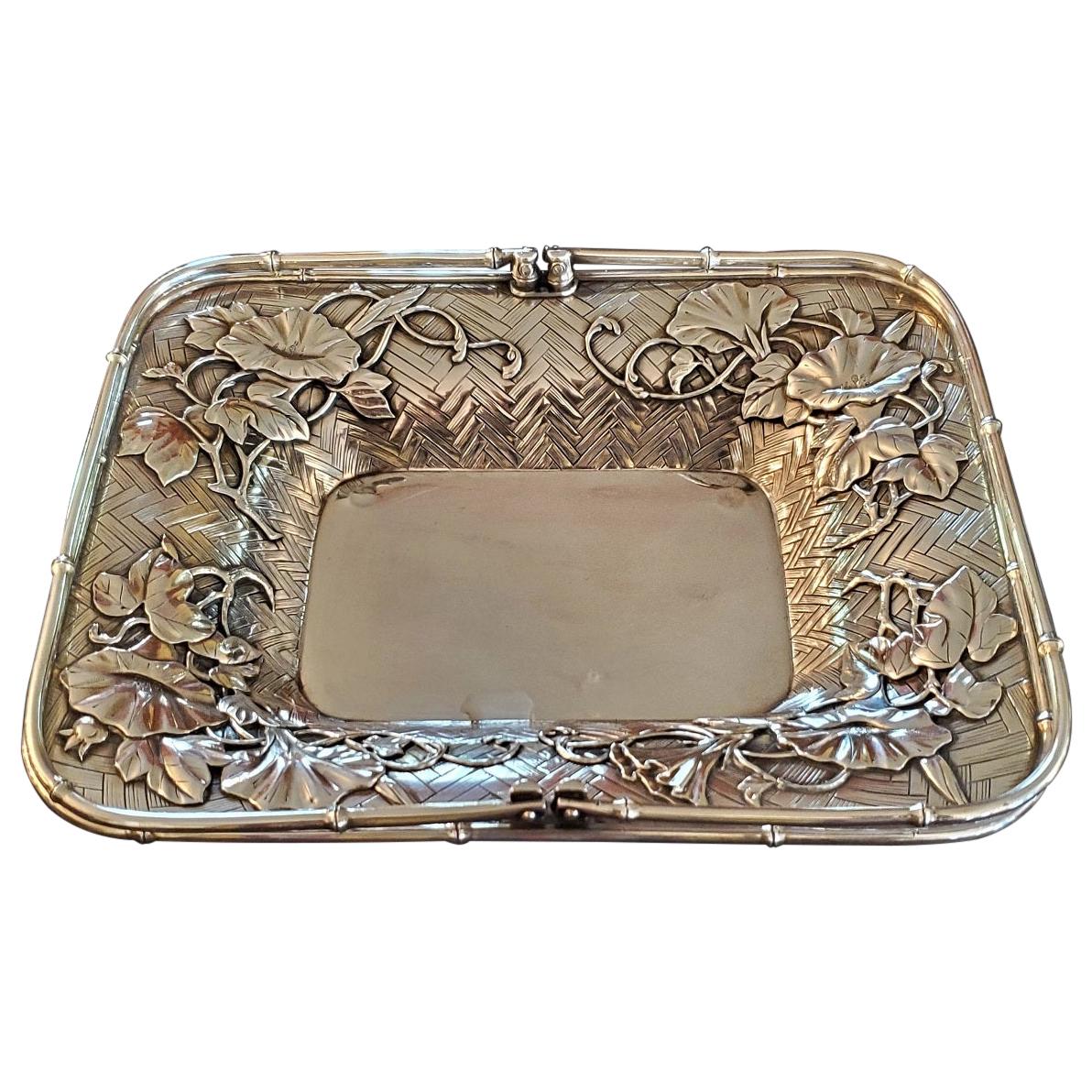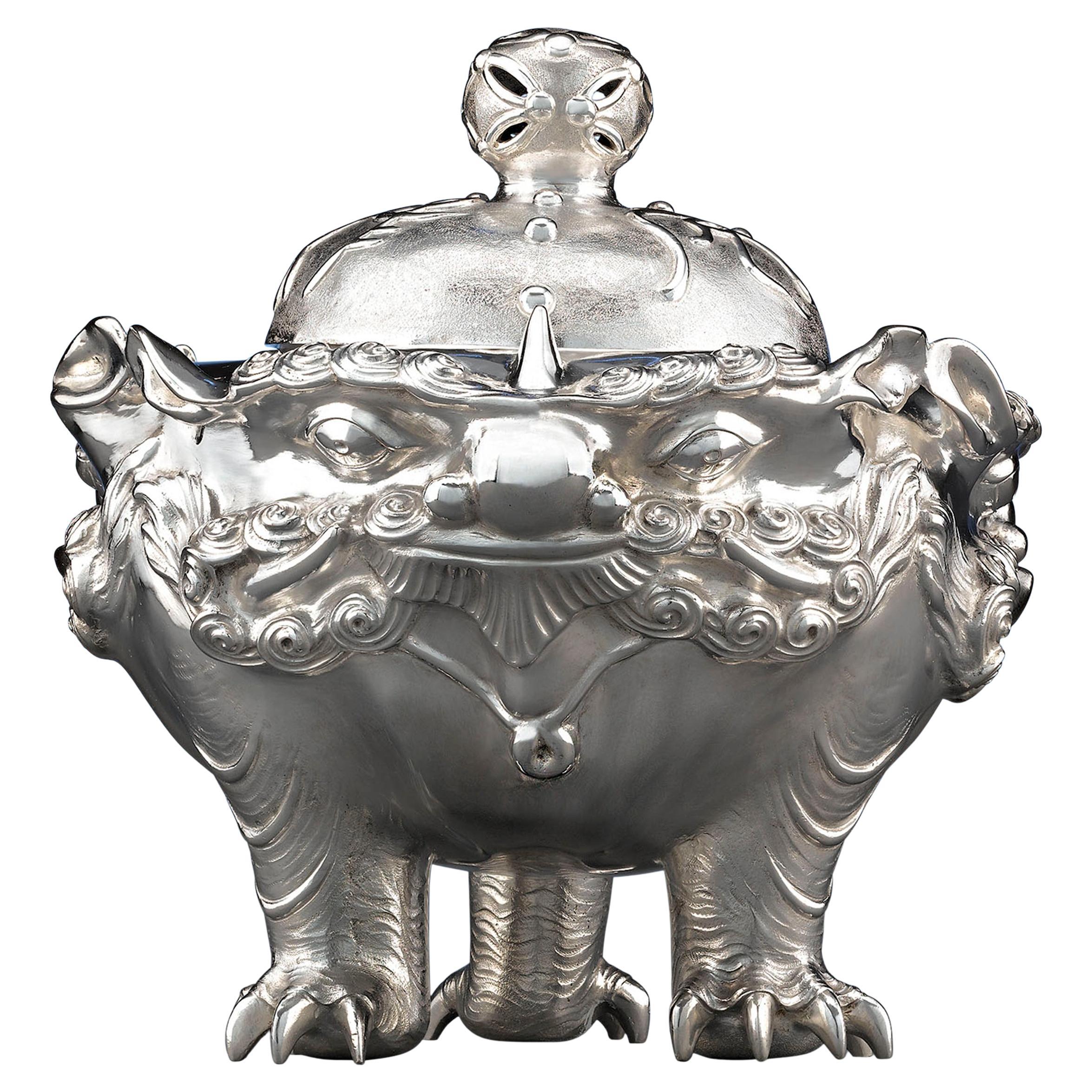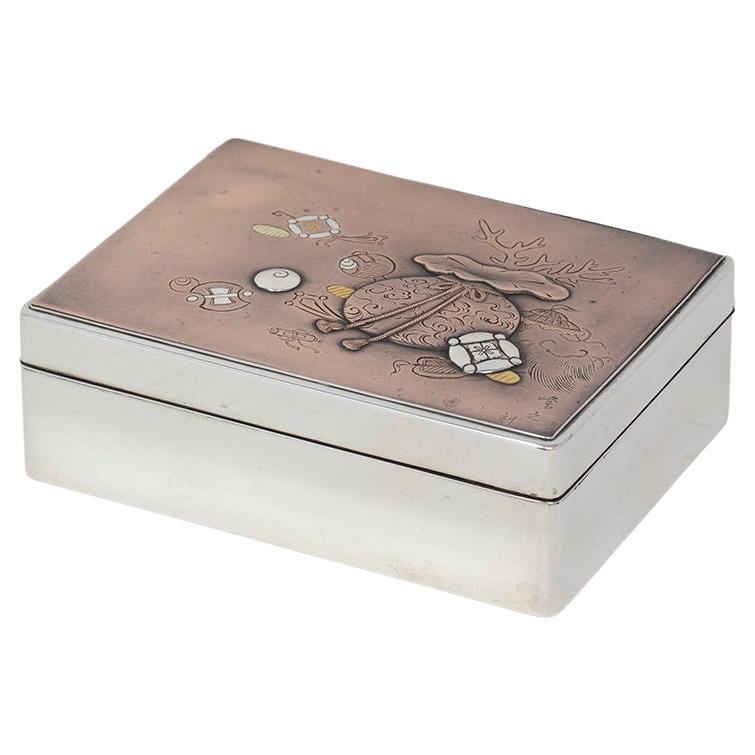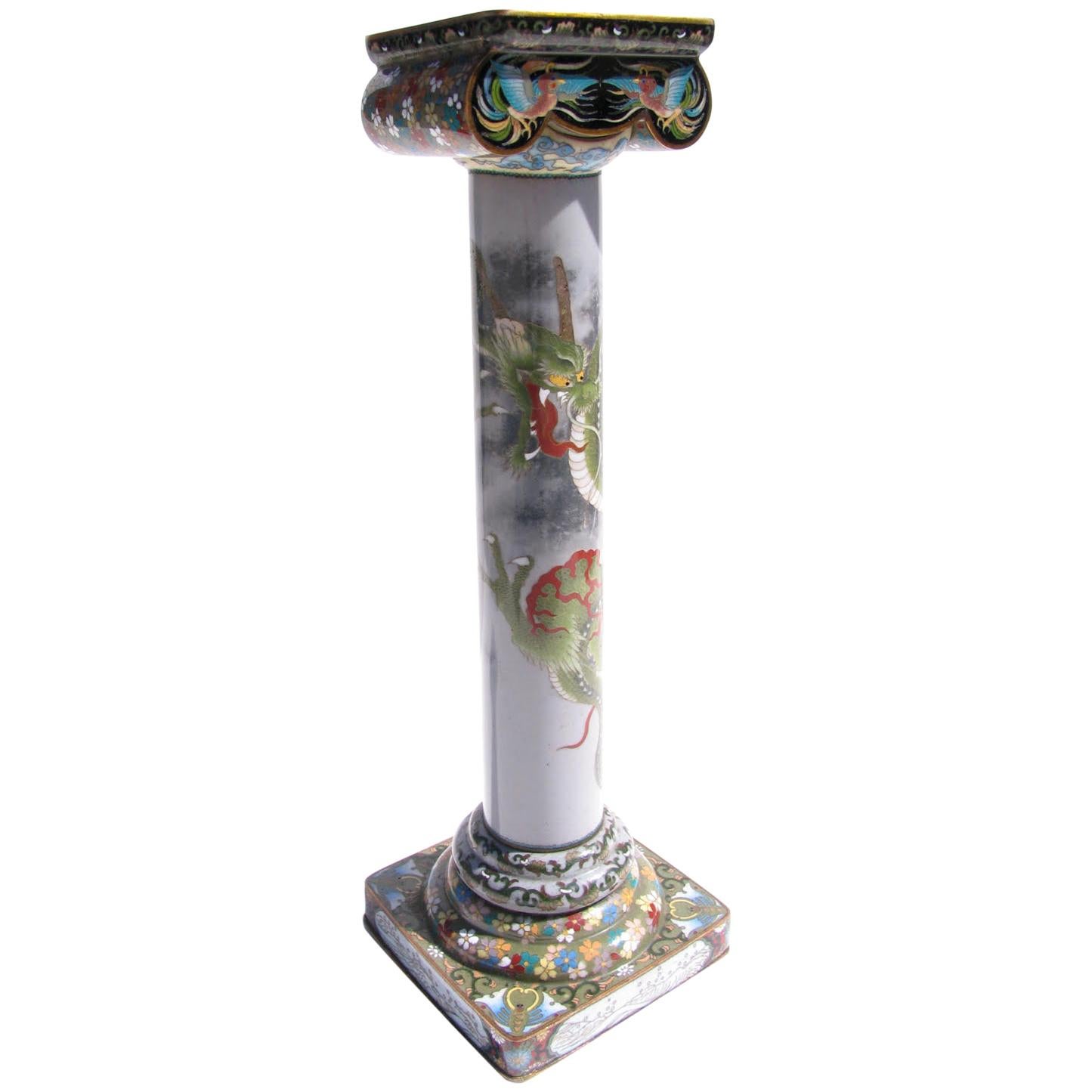Items Similar to Japanese Sterling Silver Chrysanthemum Dish Meiji Period
Want more images or videos?
Request additional images or videos from the seller
1 of 21
Japanese Sterling Silver Chrysanthemum Dish Meiji Period
About the Item
An exquisite Japanese sterling silver ornamental bonbon dish, circa 1890-1900. The piece was rendered in the shape of a stemmed branch of chrysanthemum blossom and was made for export market. Both botanically realistic and stylish, the piece showcases a high degree of artisanal sensitivity and technical ability of the silversmith who created this lovely piece. The petals that form the exteriors were outlined with deep and fluid relief lines of sculptural quality. The branches and leaves were rendered with attentions to the smallest details, with molding and surface texturizing using chasing in contrast with hammering. The interior of the dish is equipped with a conforming inner dish and when it is taken out, revealing the chased lines. The piece, although practical, is basically an okimono in sculptural form, a work of art on its own. It weighs about 22 ounces.
Under the dish, it is marked "Pure Silver" in Kanji and SM in a rectangular cartouche. The research (carried out by Adrien Von Ferscht, an expert and author on Asian Export Silver) identified it to be Sadajiro Musashiya. According to an academic paper AVF published, in 1859, Ozeki Yahei, a Japanese exporter of Japanese art and finery, set up an operation in Yokohama. His son, Ozeki Sadajiro managed the business and soon opened a retail store at 66 Main Street, called Musashiya. From there, he commissioned and exported many fine decorative art pieces including silvers to meet the western taste at the time (the Art Nouveau and the Aesthetic Movement). Musashiya collaborated with many western businessmen including Arthur Lasenby Liberty of Liberty Store of London, who visited in 1889 and formed a relationship. Many these botanically rendered pieces, mostly in the form of ornamental spoons, were exported and sold in his store in London.
- Creator:Musashiya (Maker)
- Dimensions:Height: 6 in (15.24 cm)Diameter: 6 in (15.24 cm)
- Style:Japonisme (Of the Period)
- Materials and Techniques:
- Place of Origin:
- Period:
- Date of Manufacture:1890-1900s
- Condition:Wear consistent with age and use. Fine antique silver condition with expected minor wear such as fine scratches in keeping with age.
- Seller Location:Atlanta, GA
- Reference Number:1stDibs: LU945029835822
About the Seller
5.0
Platinum Seller
These expertly vetted sellers are 1stDibs' most experienced sellers and are rated highest by our customers.
Established in 2006
1stDibs seller since 2010
479 sales on 1stDibs
Typical response time: <1 hour
- ShippingRetrieving quote...Ships From: Atlanta, GA
- Return PolicyA return for this item may be initiated within 2 days of delivery.
More From This SellerView All
- Small Japanese Articulate Crab Jizai Okimono Meiji Period SignedBy Myochin HiroyoshiLocated in Atlanta, GAA small copper crab with articulated legs made by Myochin Hiroyoshi in the late Meiji Period circa 1890-1900s. As an ornamental display item, this type of small sculpture with moving...Category
Early 20th Century Japanese Japonisme Metalwork
MaterialsCopper
- Chinese Export Sterling Silver Creamer and Sugar by CutshingLocated in Atlanta, GAA two-piece set sterling silver creamer and sugar signed "CUT" and "TienXing" in Chinese, circa second half of 19th century. Cutshing was a Chinese silversmith located at 8 New China...Category
Antique Late 19th Century Chinese Chinese Export Metalwork
MaterialsSterling Silver
- Rare Chinese Export Sterling Silver Tea Set with Dragon Design Tianjing WuhuaLocated in Atlanta, GAA Chinese export sterling silver tea set comprised of 13 pieces including tea pot, sugar, creamer, four tea bowls and six tea spoons, circa 1910s-1920s. Featuring matching chased rel...Category
Early 20th Century Chinese Chinese Export Metalwork
MaterialsSterling Silver
- Japanese Sterling Silver Centerpiece Pedestal Bowl by Hattori KintaroBy Hattori KintaroLocated in Atlanta, GAAn exquisite Japanese presentation bowl in sterling silver by Hattori Kintaro (1860 - 1934), circa 1910-1920s, late Meiji era to early Taisho era. This rare and rather large piece wa...Category
Early 20th Century Japanese Japonisme Metalwork
MaterialsMalachite, Sterling Silver
- Chinese Export Silver Dragon Serving TrayLocated in Atlanta, GAAn elaborately decorated silver serving dish or butler's tray, likely dated to the turn of the 20th century, made in China for the export market. The round tray has a solid center in...Category
Early 20th Century Chinese Chinese Export Metalwork
MaterialsSilver
- Early Chinese Export Silver Tea Service by CutshingBy CutshingLocated in Atlanta, GAAn early set of Chinese export sterling silver tea service circa 1840-70s. The service consists of a lidded tea pot, a creamer and a sugar bowl. The surface was beautifully decorated with chased high-relief dragons with tightly chased scales, slithering with open claws...Category
Antique Late 19th Century Chinese Chinese Export Metalwork
MaterialsSterling Silver
You May Also Like
- Japanese Meiji Period Sterling Silver 2 Handled Basket by Katsu MiyamotoBy Miyamoto Shoko 1Located in Dallas, TXPRESENTING a GORGEOUS, VERY HIGH QUALITY and EXTREMELY RARE piece of Japanese Meiji Period Sterling Silver 2 Handled Basket by Katsu Miyamoto. EXQUISITE, EXCEPTIONAL, RARE & IMPORTANT! This is definitely a Meiji Period piece due to the fact that it is marked with the sterling silver mark “jungin”. The Meiji period was from 1868 to 1912 and in 1928 a law was introduced in Japan compelling the use of decimal marks for silver. This pre-dates that decimalization law. We are of the opinion that it is from circa 1900. Miyamoto Shoko was founded in 1880 as the first silverware specialty shop. In 1899, Miyamoto Shoko’s silverwares were ordered by the family members of the Emperor of Japan, and to this day, they are making fine and graceful handicrafts with skillful craftsmen. Loved by numerous customers since the Meiji era, Miyamoto Shoko’s products have also been given to Princess Mako and Princess Kako of Akishino, as well as Princess Aiko Toshinomiya, on their birthdays. Katsu Miyamoto (宮本勝), in 1880, in order to increase the sales of tobacco and cigarettes to foreigners founded the Moyamoto Shoko company, which produced different silverwares in general and particularly silver cigarette cases. Miyamoto’s first name, Katsu (勝) in some sources is written as “Masaru”, since 勝 kanji can be pronounced in both ways. This basket is of the HIGHEST QUALITY imaginable! The top of the basket has the MOST GORGEOUS repousse work of flowers, probably lotus flowers, with leaves and foliage. It has an underlying chevron effect chasing, reflecting parquetry. The 2 handles are cast in the form of bamboo handles. The rim of the top likewise is cast as bamboo. The base is equally stunning in a different way! It is chased with a chevron effect, like parquetry flooring and the four feet simulate pieces of sliced bamboo with an interlinking gallery of support columns, likewise, simulating bamboo. The QUALITY of WORKMANSHIP is OUTSTANDING! The pieces weighs exactly 525 grams. This piece takes my breath away! This is one for the SERIOUS COLLECTOR of EXQUISITE AND RARE Japanese silver. You will not find another like it, for sale ANYWHERE ELSE IN THE WORLD …… I know as I have searched! Provenance: Acquired from a Dallas Private Collector. Dimensions: 9.6 inches wide, 7.6 inches deep and 2.75 inches tall ( 7.25 inches tall with handles up) Condition: Very good. It looks like the base 4 legged gallery, has been repaired/re-attached to the base, but otherwise it is excellent and of Museum quality. The Meiji period (明治時代 Meiji-jidai?), also known as the Meiji era, is a Japanese era which extended from October 23, 1868 through July 30, 1912.[1] This period represents the first half of the Empire of Japan during which Japanese society moved from being an isolated feudal society to its modern form. Fundamental changes affected its social structure, internal politics, economy, military, and foreign relations. The period corresponded with the reign of Emperor Meiji after 1868, and lasted until his death in 1912. It was succeeded by the Taishō period upon the accession of Emperor Taishō to the throne. Solid silver pieces...Category
Early 20th Century Japanese Meiji Metalwork
MaterialsSterling Silver
- Large Japanese Cloisonné Enamel Dish, Japan Meiji periodLocated in Saverne, Grand EstBronze and cloisonné enamel dish very finely decorated with an egret in flight above various flowers on a background of copper inclusions and gold powder. The wing decorated in parti...Category
Antique Late 19th Century Japanese Meiji Metalwork
MaterialsBronze
- Meiji Period Japanese Silver CenserLocated in New Orleans, LAThis stunning Meiji period silver censer is a work of exquisite detail. Crafted by renowned silversmith Masatoshi of Tokyo, the censer, or incense burner...Category
20th Century Japanese Meiji Metalwork
MaterialsSilver
- Japanese Silver Repousse Iris Vase Meiji PeriodBy Samurai ShokaiLocated in Gainesville, FLJapanese silver repousse vase finely decorated with blown out iris flowers. It is of the Meiji period, circa 1890s. The vase is 5 1/4" tall and weighs 4....Category
Antique 19th Century Japanese Metalwork
MaterialsSilver
- Japanese Meiji Period Silver Box Signed MasayukiLocated in Newark, EnglandJapanese Meiji period silver box with shibuichi plaque dating circa 1900. The box of rectangular form with a silver polished case stamped Jungin (J...Category
Antique Early 1900s Meiji Metalwork
MaterialsSilver
- Japanese Meiji Period Cloisonne Dragon Candlestick HolderLocated in New York, NYExquisite Japanese Meiji period Cloisonne candlestick holder decorated with a dragon. Finely detailed metal and enamel work. In excellent age a...Category
Antique 19th Century Japanese Japonisme Candlesticks
MaterialsMetal
Recently Viewed
View AllMore Ways To Browse
Japanese Interior Furniture
Asian Botanical
1890 Japan
Black Dish
Dish Sets Used
Japanese Relief
Fine Meiji Japan
Japanese Art Nouveau
Art Nouveau Japan
Silver Sm
Aesthetic Movement Japanese
Sterling Japan
Chrysanthemum Japanese
Chrysanthemum Japan
Retail Store
Antique Dish Set
Antique Dish Sets
Antique Furniture Market London





